
Mind Reading
Humans cannot literally read the minds of others, but can create mental models so as to effectively intuit people's thoughts and feelings. This is known as empathic accuracy, and it involves “reading” cues telegraphed by the words, emotions, and body language of another person.
Most people are able to read others to some degree, but those on the autism spectrum or individuals afflicted with psychotic disorders may struggle to discern the emotions or social cues of others.
Often, knowing our own mind and motivations is challenging enough, let alone the minds of strangers or even relatives, friends, or partners. In relationships, many people make the critical mental mistake of overestimating a partner or family member's ability to read their own thoughts, assuming that anyone who knows them well should also know what they think or feel, even if they haven't said it out loud.
In science fiction stories, mind reading is routinely used for nefarious purposes. In the real world, having a clear sense of what others think and feel helps us avoid conflict and miscommunication and strengthen personal relationships.
When attempting to read someone’s mind—or, more accurately, their mood—body language, tone, and choice of words are usually the best places to begin. Another critical element is empathy: Being able to put oneself in someone else’s shoes can provide key insights into their perspective, and make understanding their thoughts, feelings, and actions that much easier.
Research suggests that our discernment of others’ emotions and trustworthiness may manifest in our body’s reactions to them at least as strongly as in our mental assessments of their speech. Trusting one’s gut, then, by being mindful of our body’s reactions to someone else, can help us make more accurate judgments about others.
When trying to read other people, we tend to look to their faces. Research shows that while the faces of happy people take on a V shape, with eyebrows and mouths turned up, angry people’s faces form more of an X, with eyebrows and mouths turned downward. Being conscious of this tendency in others and ourselves can improve communication and understanding.
Romantic partners are not much better at reading each other’s feelings than they are at reading anyone else’s. By some estimates, even spouses may only gauge each other accurately about a third of the time. Partners may struggle to struggle to judge each other objectively because of sentiment override, in which one’s own feelings about a relationship influence their interpretation of a partner’s feelings.
As children, individuals raised in different cultures learn to adopt local norms for the display and expression of emotions. In places such as Japan, for example, people may emphasize masking emotions when others are present. People also read others differently based on their particular “cultural accents.” For example, Americans rate expressions of happiness, sadness, and surprise more intensely than other people do.
Even the most socially adept individuals routinely misread other people's emotions because of their own biases, cultural tendencies, or situational factors, such as not realizing someone who appears to have been crying may only have seasonal allergies. A greater knowledge of how others display their feelings, and, equally importantly, how our minds and bodies respond to the feelings of others, can help improve people-reading skills.
Humans have also evolved ways to keep feelings and motives opaque and, with practice and intention, can successfully mislead others. Those experiencing grief or depression, for example, may put effort into covering up those feelings to avoid feeling as if they are burdening others or to avoid others’ advice.
It has long been believed that people’s body language gives them away—that people have “tells” that could tip observant others off to their true intentions. Reading others can become more efficient, research shows, when we consciously focus on such clues. For example, facial features like the eyes and the mouth may offer a great deal of information, but if we are looking at the whole person we may miss seeing what their faces have to tell us.
The face is the primary medium for conveying emotion, but overall body language also plays a role. Often, even when we strive to keep our facial expression neutral, our overall body language still gives us away. To avoid revealing too much in social or professional situations, it’s important to consider both facial and body cues.
Several psychiatric and behavioral disorders, like autism and ADHD, make reading the thoughts and feelings of others a challenge. Although people with autism and ADHD don’t routinely lack empathy, they may struggle to pick up on subtle hints, or may respond impulsively without taking the time to assess someone’s words or tone.
These difficulties likely have roots in multiple areas of the brain; some research has pointed to atypical activity in the anterior cingulate cortex, a region of the brain which plays a role in emotion, moral decisions, and social evaluation.
Along with conditions like autism, research into empathic accuracy has focused on the socially anxious, who can struggle with reading emotions because they find social interactions unpredictable or confusing. But studies have also found that there appear to be two types of socially-anxious people—some struggle with reading others, while a smaller number actually excel at mind reading, to the extent that it leads to a heightened awareness of others and a heightened sensitivity to being evaluated themselves.
Behavioral therapy can help people living with autism, ADHD, and other developmental disorders learn to better recognize common social cues that, when unnoticed, make it difficult to read other people’s thoughts and respond appropriately.














